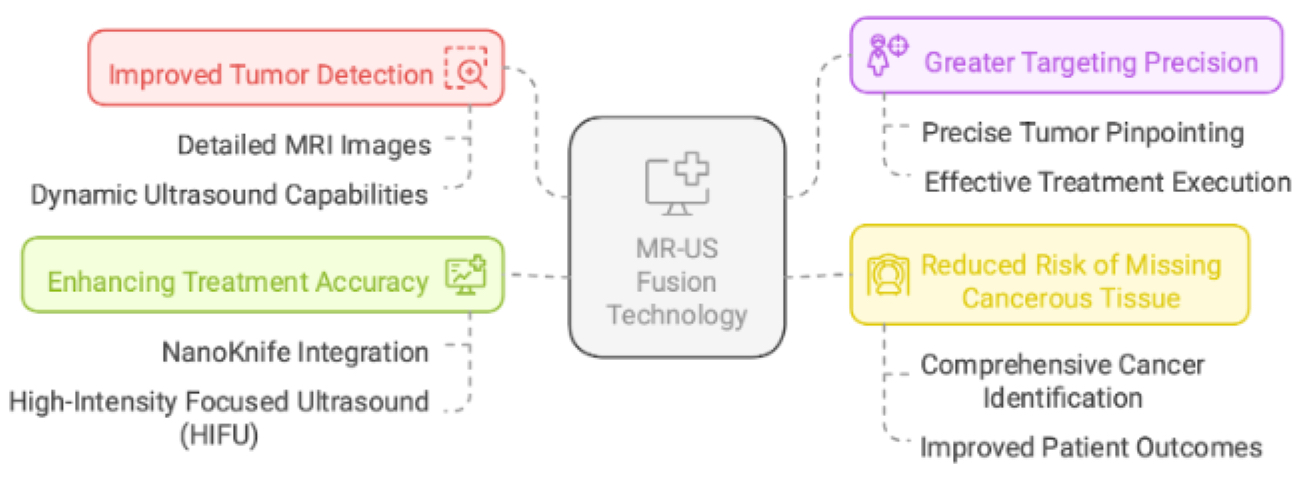
NanoKnife: IRE focal therapy treatment
- Minimally-invasive treatment
- Targets and destroys cancerous prostate tissue with precision
- Can also destroy tumours that can't be reached with HIFU

Treatments Completed

and Erectile problems
Fast recovery
Outpatient procedure with quick recovery time (2-3 days)
Little to no side effects
Low risk of incontinence and impotence
Minimally invasive
No hormones, radiation or incisions
NanoKnife Irreversible Electroporation (IRE) is an advanced, minimally invasive treatment for prostate cancer that uses electrical pulses to destroy cancerous cells while preserving surrounding healthy tissue. NanoKnife IRE works at a cellular level without causing thermal damage, making it an excellent option for men with tumours at the front of their prostate gland.
NanoKnife has been used in the treatment for cancer tumours since 2008 and has been approved by NICE for use with Prostate Cancer tumours since 2022.
Which Consultants Perform the Procedure?
At The Focal Therapy Clinic, all of our expert consultant urologists have extensive experience in NanoKnife IRE treatments, ensuring optimal patient outcomes.
Our consultant Uro-Radiologist team prepare precise treatment plans for each patient based upon a detailed review of their MRI and Biopsy results. The use of these treatment plans in theater ensures enhanced cancer control and reduced risk of urinary or erectile function side effects.
Learn more about how NanoKnife works
| Feature | NanoKnife IRE |
|---|---|
| Treatment Type | Minimally invasive focal therapy |
| Temporary swelling | Common |
| Energy Used | Electrical pulses (non-thermal) |
| Hospital Stay | Outpatient (same day) |
| Cancer cure rate at 3 years | 95% + |
| Urinary Incontinence Risk | Very low (<1%) |
| Erectile Problems | <3% |
| Repeatable Treatment? | Yes |
| Best for Tumour Location | Tumours located at the front (anterior) of the prostate |
| Suitability | Men eligible for focal therapy where tumour location is in the front of the prostate rather than the base of the prostate gland |
| Follow-Up Care | Regular PSA testing and occasional MRI scans |
“If you’re deemed suitable for [NanoKnife], it really is a no brainer. I think to go down this line first is the only way if you want to minimise your possible after effects.”
Brian Bishop
The Focal Therapy Clinic patient
Is NanoKnife right for me?
NanoKnife for Prostate Cancer is a minimally-invasive treatment for men with localised prostate cancer in parts of the prostate that are too hard for HIFU to reach. NanoKnife could be right for you if your prostate cancer is:
Early or intermediate stage
In the anterior or lateral parts of the prostate
Localised
Recurrent
It could also be the right choice if you are keen to avoid long-time side effects from prostate cancer treatment.
Check your suitability
Success rates
NanoKnife: Advantages and Disadvantages
Advantages
- Minimally invasive - No incisions, no radiation, no hormones
- Preserves sexual function & continence - spares nerves and urinary structures
- Outpatient procedure - Go home the same day. Rapid recovery
- Repeatable if needed - Can be combined with other treatments
- Effective cancer control - equivalent to radiotherapy or surgery at 8 years
Disadvantages
- Minimally invasive - No incisions, no radiation, no hormones
- Follow-up monitoring required - Regular PSA testing and MRI scans needed
- Limited long-term data - NanoKnife is newer than traditional treatments.
What to Expect Before, During, and After Treatment
What to Expect Before, During, and After Treatment
- MRI and biopsy to confirm eligibility
- Pre-Procedure instructions (e.g. fasting)
Side effects & Risks
| Symptom | Frequency | Duration |
|---|---|---|
| Urinary Catheter required | Always | 3-5 Days |
| Mild discomfort in perineum area | Common | 2-3 Days |
| Temporary swelling and bruising | Common | 2-3 Weeks |
| Blood in urine or semen | Common | Up to 8 weeks |
| Erectile dysfunction | Rate (<5%) | Usually temporary |
| Return to normal | Common | 3 - 7 days |
Questions to ask your doctor

“NanoKnife was more accurate for the awkward position of my cancer.” — Brian Bishop
“NanoKnife gives us a high level of control around the ablation area.” — Mr. Alan Doherty
“NanoKnife's precision reduces side effects like incontinence.” — Mr. Tim Dudderidge
“I've had no lasting after-effects whatsoever—less discomfort than a filling.” — Brian Bishop
“MRI quality is key; poor scans undermine focal therapy decisions.” — Mr. Tim Dudderidge
Choosing Between NanoKnife & HIFU: Key Factors
| Benefit | NanoKnife | Hifu |
|---|---|---|
| Best for Tumour Location | Irregularly shaped or near critical structures (nerves, urethra) | Well-defined tumors in specific prostate zones |
| Preservation of Nerves | No heat damage; excellent for preserving erectile function | Low risk, but heat may affect nearby structures |
| Suitability for Recurrent Cancer | Ideal for post-radiation recurrence | For tumors near the base of the prostate |
| Side Effects | Minimal impact on urinary function and sexual health | Low risk of incontinence and erectile dysfunction |
| Treatment risk | Risk of rectal injury at base of prostate | Risk of under treatment at front of prostatetd> |
The Role of MR-US Fusion Technology in Treatment Accuracy
Benefits of MR-US Fusion Technology
- Improved Tumour Detection - More accurate than ultrasound alone
- Greater Targeting Precision - Helps specialists precisely pinpoint tumours
- Reduces Risk of Missing Cancerous Tissue - Ensures comprehensive tumour destruction

Frequently asked questions
There are many factors to consider when choosing a treatment for your prostate cancer. Medical factors, such as your cancer stage and tumour location are important. However, your current and future quality of life is also very important.
Reference List
Blazevski, A., Scheltema, M. J., Amin, A., Thompson, J. E., Lawrentschuk, N., & Stricker, P. D. (2020). "Irreversible electroporation (IRE): A narrative review of the development of IRE from the laboratory to a prostate cancer treatment." BJU International, 125(3), 369–378. https://pubmed.ncbi.nlm.nih.gov/31725935/
Valerio, M., Dickinson, L., Ali, A., Ramachandran, N., Donaldson, I., McCartan, N., Freeman, A., Ahmed, H. U., & Emberton, M. (2017). "Nanoknife Electroporation Ablation Trial: A prospective development study investigating focal irreversible electroporation for localized prostate cancer." The Journal of Urology, 197(3 Pt 1), 647–654. https://pubmed.ncbi.nlm.nih.gov/27697580/
lazevski, A., Scheltema, M. J., Yuen, B., Masand, N., Nguyen, T. V., Delprado, W., Shnier, R., Haynes, A. M., Cusick, T., Thompson, J., & Stricker, P. (2020). "Oncological and quality-of-life outcomes following focal irreversible electroporation as primary treatment for localized prostate cancer: A biopsy-monitored prospective cohort." European Urology Oncology, 3(3), 283–290. https://pubmed.ncbi.nlm.nih.gov/31103721/
The Focal Therapy Clinic Resources: www.thefocaltherapyclinic.co.uk







